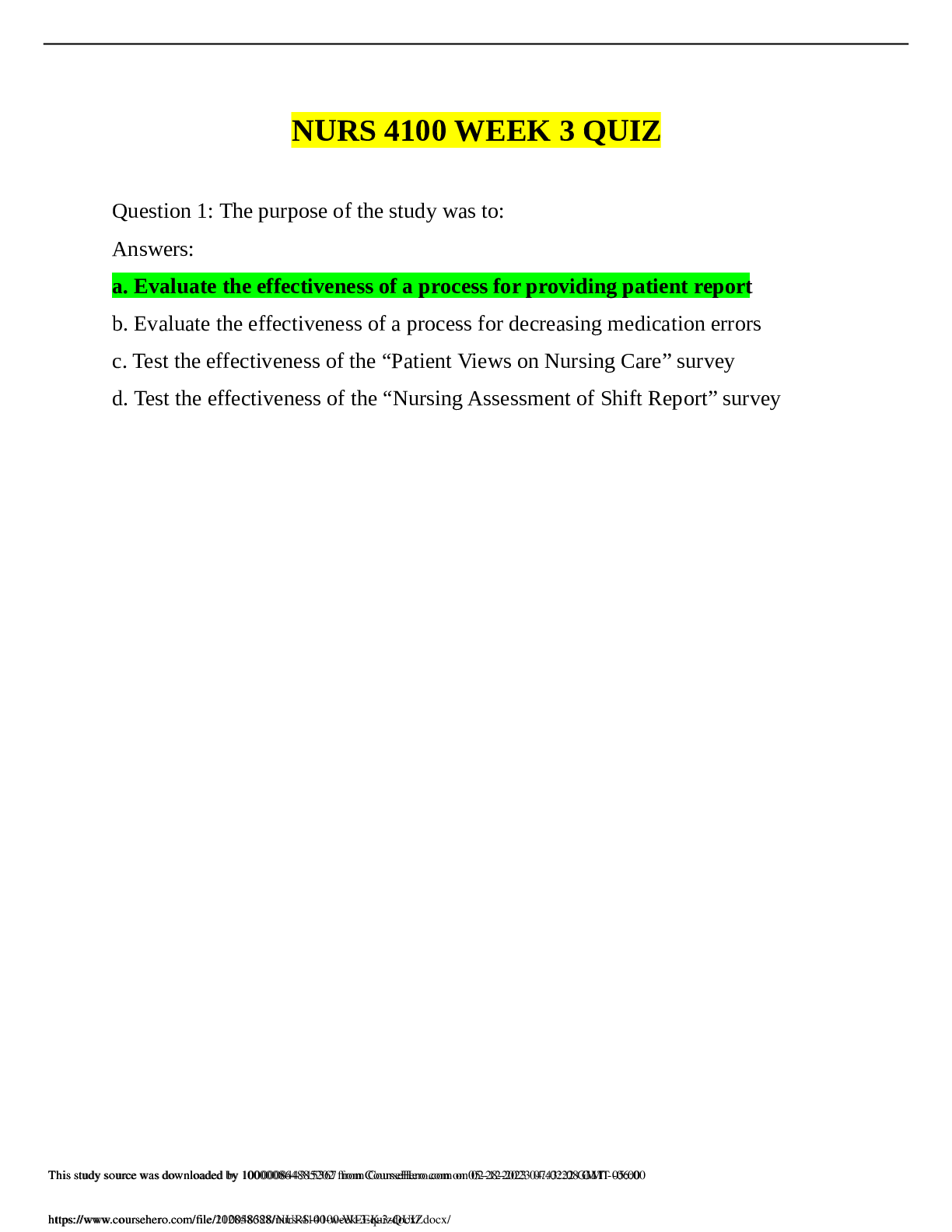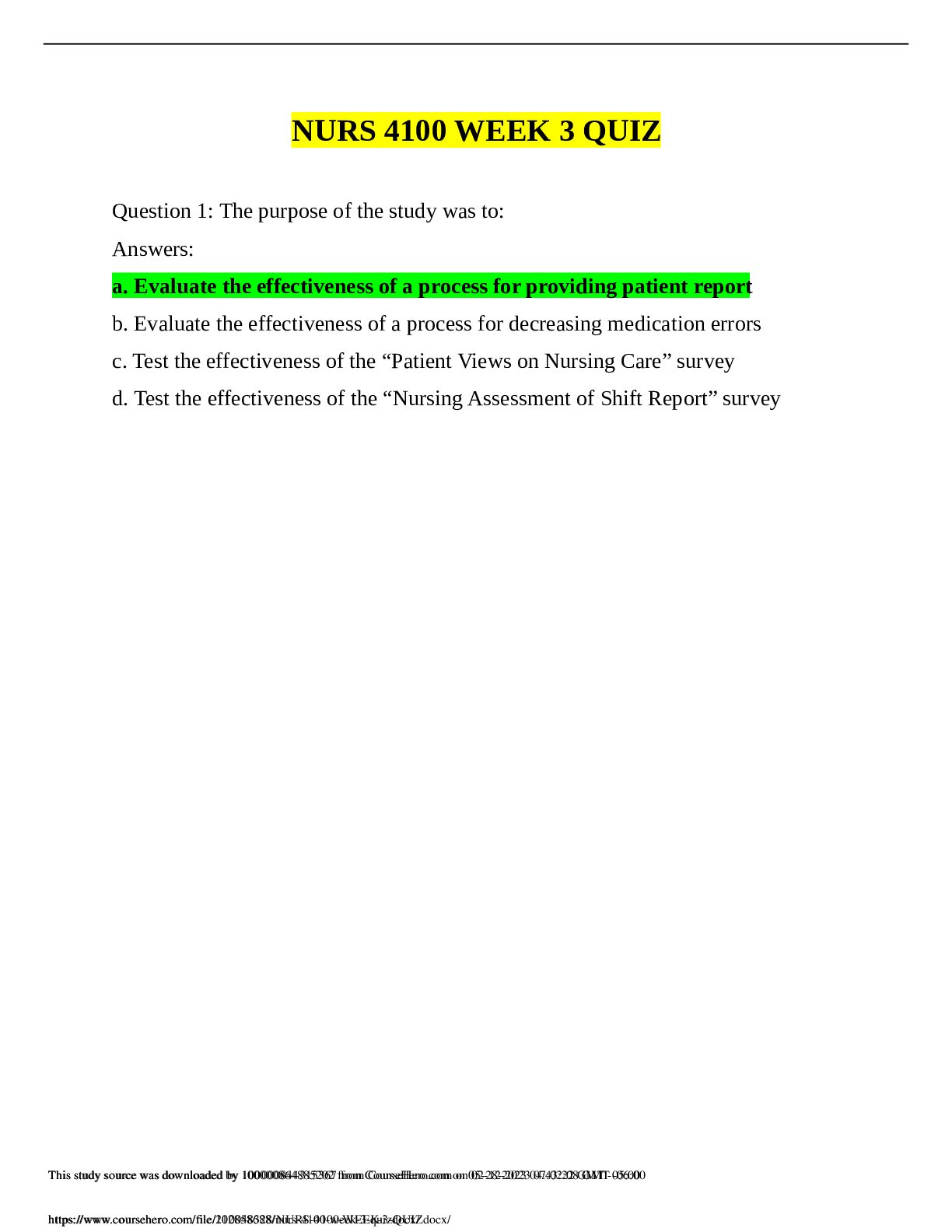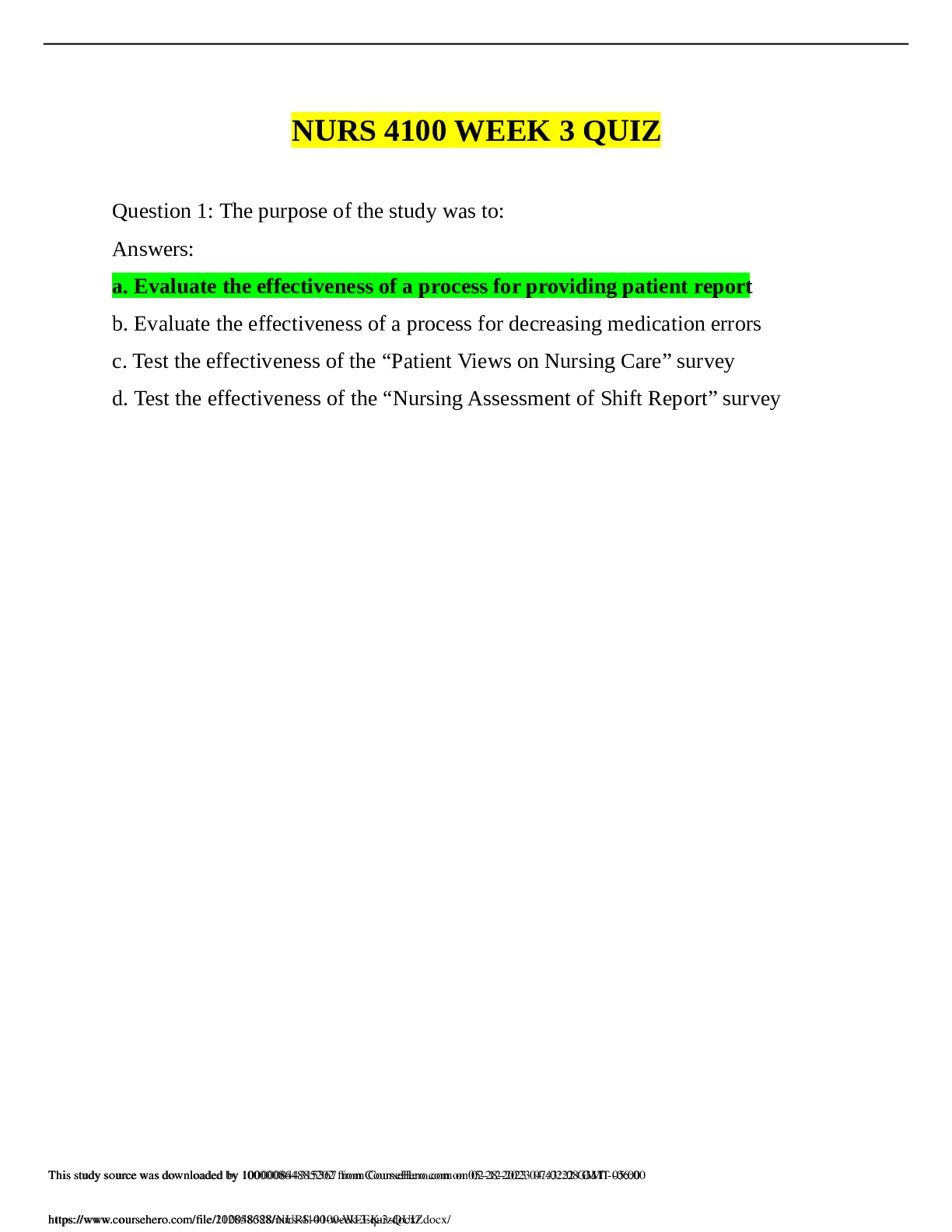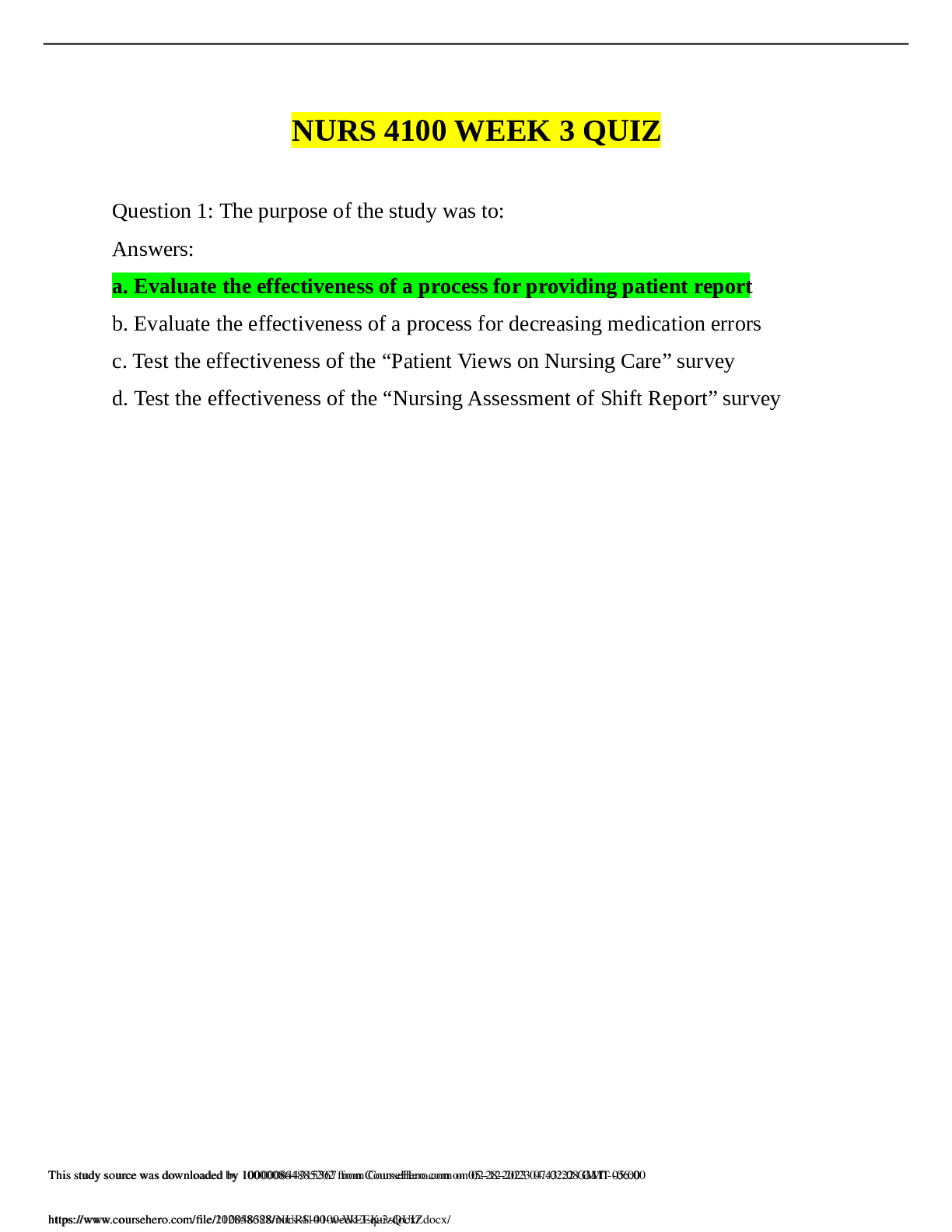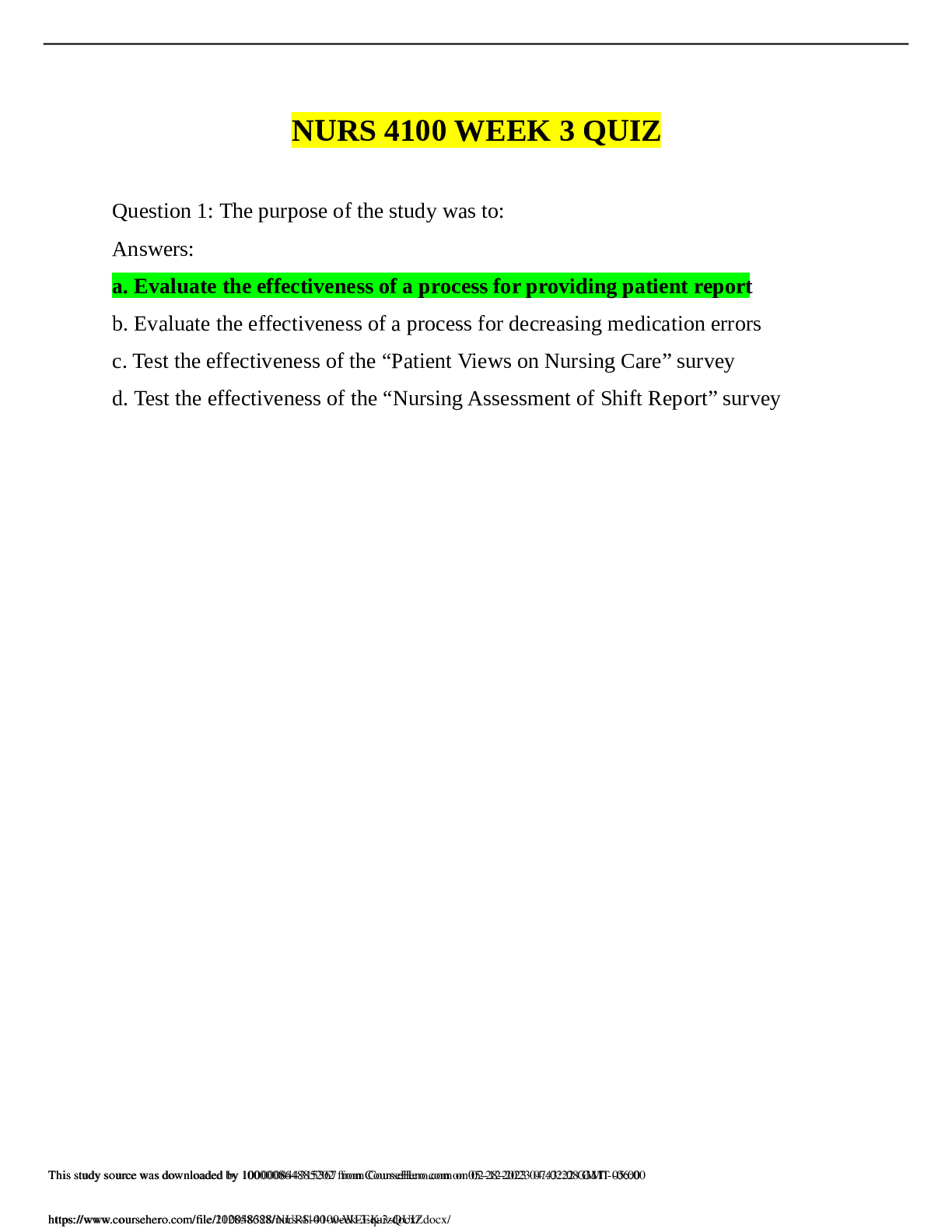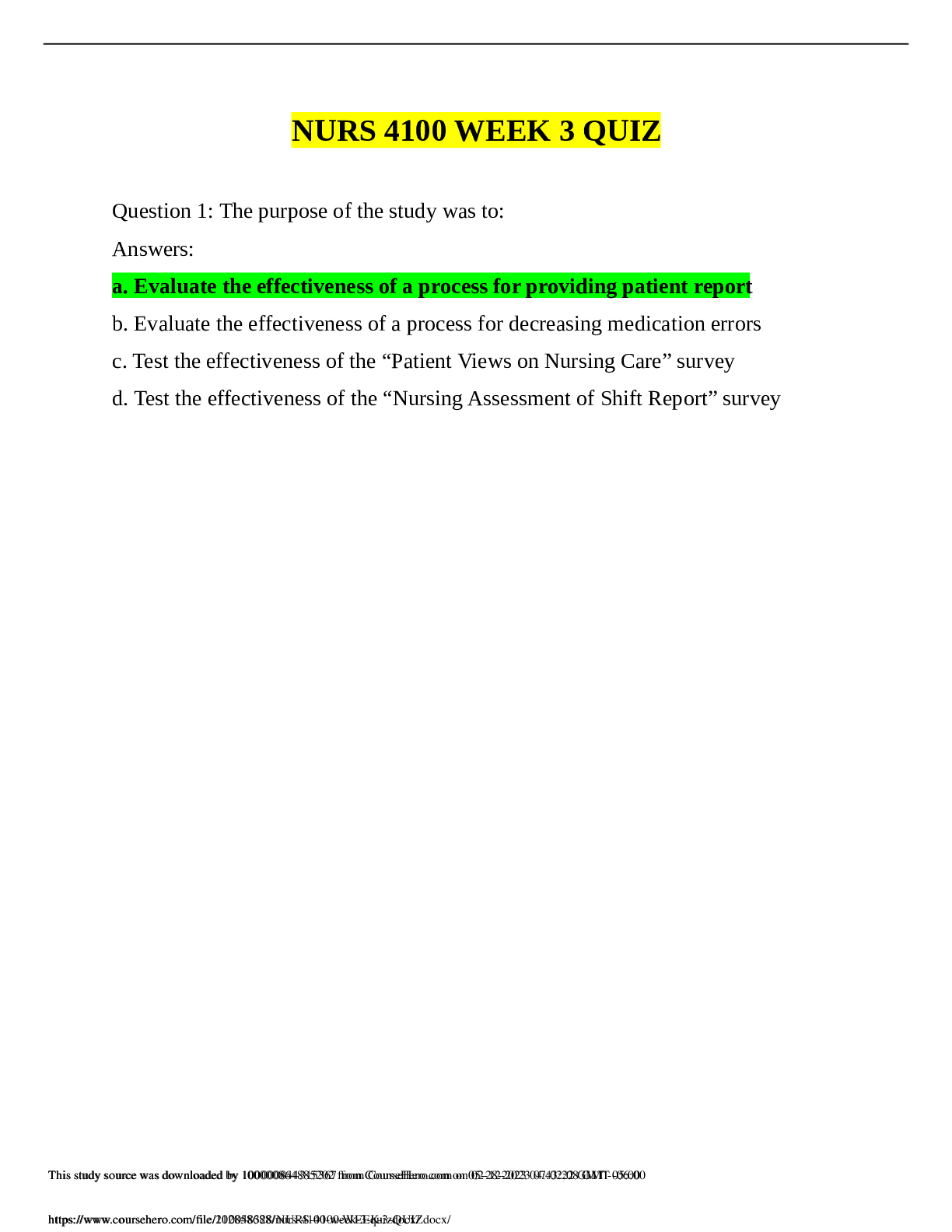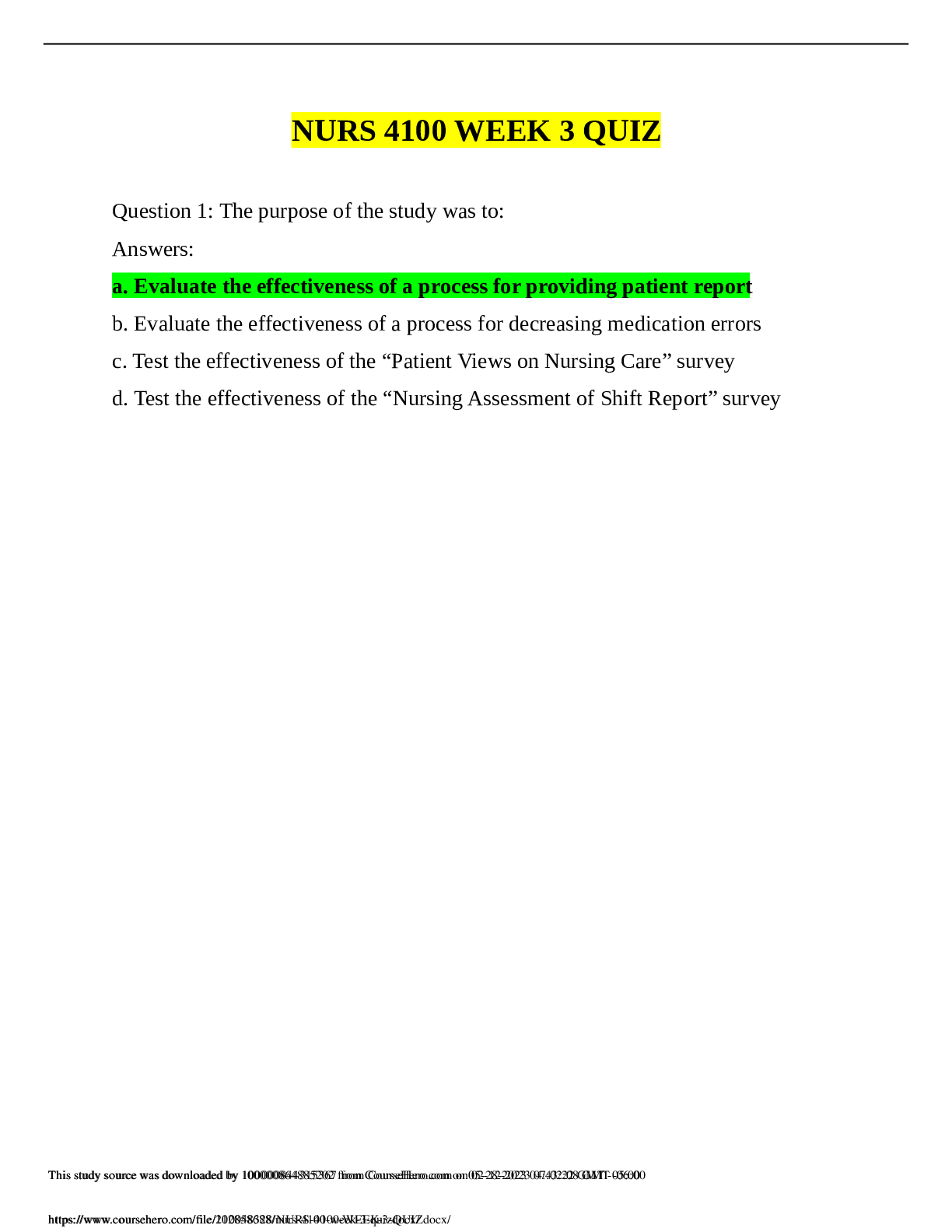*NURSING > EXAM > CAUTI reduction: What can we do? Walden University NURS 4100 Week 5 Assgnment: Quality and Safety th (All)
CAUTI reduction: What can we do? Walden University NURS 4100 Week 5 Assgnment: Quality and Safety through Evidence-Based Practice May 9, 2020: Essay + Quantitative Study With Q&A. +
Document Content and Description Below
As a nurse, we face clinical practice problems daily. As stated by the Agency for Healthcare Research and Quality, an estimated 560,000 patients develop hospital-acquired UTIs per year. We use evide... nce-based practice to research and develop solutions to problems. Brown states that evidence-based practice is the use of care methods that have been endorsed by an agency because available evidence indicates they are effective (Brown, 2018). In nursing we use research to determine the best way to solve a clinical problem (Nieswiadomy, 2008). Nurses use evidence-based nursing to look for solutions (Nieswiadomy, 2008). Evidence-based nursing practice is defined (Nieswiadomy, 2008) as “nursing practice that is based on the best available evidence, particularly research finding” (p. 401). The purpose of this assignment is to reflect how nursing studies are used to come to a solution to everyday problems. References Agency for Healthcare Research and Quality. https://www.ahrq.gov Bernard, M. S., Hunter, K. F., & Moore, K. N. (2012). A Review of Strategies to Decrease the Duration of Indwelling Urethral Catheters and Potentially Reduce the Incidence of Catheter- Associated Urinary Tract Infections. Urologic Nursing, 32(1), 29-37 Brown, S. (2018). Evidence-based nursing: The research practice connection. Burlington, MA: Jones and Bartlett Learning. Griffiths, R., & Fernandez, R. (2007). Strategies for the removal of short-term indwelling urethral catheters in adults. Cochrane Database of Systematic Reviews, (2). Nieswiadomy, R. M. (2008). Foundations of nursing research. (5th ed.). Upper Saddle River, New Jersey: Pearson Prentice Hall. Oman, K. S., Flynn, Fink, R., Schraeder, N., Hulett, T., Keech, T., & Wald, H. (2012). Nurse-directed interventions to reduce catheter-associated urinary tract infections. American Journal Of Infection Control, 40(6), 548-553. doi:10.1016/j.ajic.2011.07.018 Rothfeld, A., & Stickley, A. (2010). A program to limit urinary catheter use at an acute care hospital. American Journal Of Infection Control, 38(7), 568-571. doi:10.1016/j.ajic.2009.12.017 Bentlinger, L., Blanck, A., Donahue, M., Polito, C., & Stinger, K. (2014, March). A quasi-experimental study to test a prevention bundle for catheter-associated urinary tract infections. Journal of Hospital Administration, 3(4), 101-108. This was a quantitative study. What was the purpose of the study (research questions, purposes, and hypotheses)? The purpose of the study was to test the effect of using a bundled approach of catheter care practices for a 3-month period to reduce the occurrence of CAUTI’s. The research question was: What is the effect of performing a consistent prevention bundle on all patients in the adult CCU with urinary catheters to prevent CAUTI’s as compared to patients who did not receive the prevention bundle in the prior year? How was the sample obtained? Two sample groups were used: a pre-intervention comparison group and an intervention group.Comparison group consisted of all patients with urinary catheters admitted to the adult CCU form October 1, 2012 through December 31, 2012. The intervention group consisted of all patients with urinary catheters admitted to the adult CCU from October 1, 2013 through December 31, 2013. What inclusion or exclusion criteria were used? Exclusion criteria for the study included patients admitted to the CCU who were less than 18 years of age, those who did not have indwelling catheters, or those who had been admitted with a UTI or developed a UTI prior to the two calendar day criteria. Any patients with suprapubic catheters or intermittent catheterizations were excluded. Who from the sample actually participated or contributed data (demographic or clinical profile and dropout rate)? A retrospective record review was used to compare pre- and post-implementation. What methods were used to collect data (e.g., sequence, timing, types of data, and measures)? A patient cencus log was maintained of the patients each day that had urinary catheters. The Wilcoxin signed rank test was used to compare CAUTI rates between the pre- and post- intervention time periods. Was an intervention tested? Yes, a bundled approach was tested. How was the sample size determined? There was no set sample size. The sample size was just determined by the date range. Were patients randomly assigned to treatment groups? What are the main findings? No they were not randomly assigned Credibility Is the study published in a source that required peer review? yes Was the design used appropriate to the research question? yes *Did the data obtained and the analysis conducted answer the research question? Yes Were the measuring instruments reliable and valid? yes *Were important extraneous variables and bias controlled? Yes, bias was controlled by including all patients with indwelling catheters that did not have a UTI when entering the study. *Was the study free of extraneous variables introduced by how, when, and where the study was done? yes *If an intervention was tested, answer the following five questions: 1. Were participants randomly assigned to groups and were the two groups similar at the start (before the intervention)? Not randomly assigned but they were similar at the start. 2. Were the interventions well defined and consistently delivered? yes 3. Were the groups treated equally other than the difference in interventions? yes 4. If no difference was found, was the sample size large enough to detect a difference if one existed? yes 5. If a difference was found, are you confident it was due to the intervention? yes Are the findings consistent with findings from other studies? yes Are the findings credible? yes Clinical Significance Note any difference in means, or measures of clinical effects (ABI, NNT, RR, OR). Intervention was only carried out on one floor so it was consistent. *Is the target population clearly described? yes *Is the frequency, association, or treatment effect impressive enough for you to be confident that the finding would make a clinical difference if used as the basis for care? Yes, there was a 50% reduction in CAUTIs. Are the findings clinically significant? yes Boltz, M., Capezuti, E., Fnk, R., Gilmartin, H., Richard, A., & Wald, H. (2012). Indwelling urinary catheter management and catheter-associated urinary tract infection prevention practices in Nurses Improving Care for Healthsystem Elders Hospital. American Journal of Infection Control. This was both a qualitative and quantitative study. What was the purpose of the study (research questions, purposes, and hypotheses)? To evaluate and compare the care practices for CAUTI prevention. How was the sample obtained? A survey request was sent out to Nurses Improving the Care of Healthsystem Elders program. The sample was nonrandom. What inclusion or exclusion criteria were used? None. Who from the sample actually participated or contributed data (demographic or clinical profile and dropout rate)? 75 acute care hospitals out of 255 participated. There was no difference between responding and non-responding hospitals in terms of bed size and setting. What methods were used to collect data (e.g., sequence, timing, types of data, and measures)? A survey was used for baseline data collection. Data was then entered into SPSS for statistical comparison. Was an intervention tested? No 1. How was the sample size determined? There was no set determination on size. A survey request was sent out to all 255 participants. 2. Were patients randomly assigned to treatment groups? What are the main findings? N/A Credibility Is the study published in a source that required peer review? yes Was the design used appropriate to the research question? yes *Did the data obtained and the analysis conducted answer the research question? yes Were the measuring instruments reliable and valid? yes *Were important extraneous variables and bias controlled? No. They were volunteered participants, so they could have been bias in CAUTI prevention. Information was self-reported so could possibly not have been accurate. It was not representative of hospitals nationwide. *Was the study free of extraneous variables introduced by how, when, and where the study was done? yes *If an intervention was tested, answer the following five questions: 1. Were participants randomly assigned to groups and were the two groups similar at the start (before the intervention)? 2. Were the interventions well defined and consistently delivered? 3. Were the groups treated equally other than the difference in interventions? 4. If no difference was found, was the sample size large enough to detect a difference if one existed? 5. If a difference was found, are you confident it was due to the intervention? Are the findings consistent with findings from other studies? yes Are the findings credible? yes Clinical Significance *Are the findings rich and informative? Yes. *Is the perspective provided potentially useful in providing insight, support, or guidance for assessing patient status or progress? Yes, it is a good start on insight of wear practices are missed. What experience, situation, or subculture does the researcher want to understand? They are reviewing the adherence to CAUTI prevention practices. Does the researcher want to produce a description of an experience, a social process, or an event, or is the goal to generate a theory? The goal is to generate a theory. Are specific pieces of data (e.g., direct quotes) and more generalized statements (themes, theories) included in the report? There are specific pieces of data, such as statistics, represented in the survey. Oman, K. S., Flynn, Fink, R., Schraeder, N., Hulett, T., Keech, T., & Wald, H. (2012). Nurse-directed interventions to reduce catheter-associated urinary tract infections. American Journal Of Infection Control, 40(6), 548-553. doi:10.1016/j.ajic.2011.07.018 This was a quantitative study. What was the purpose of the study (research questions, purposes, and hypotheses)? to develop and implement interventions to decrease the amount of CAUTI incidence How was the sample obtained? A pre/post intervention design was used to enable the researchers to determine if there was a change after each intervention by comparing the patients before and after the intervention was used. What inclusion or exclusion criteria were used? excluded those who had underdone urologic surgery Who from the sample actually participated or contributed data (demographic or clinical profile and dropout rate)? One hospital What methods were used to collect data (e.g., sequence, timing, types of data, and measures)? The authors provided a short, but concise literature review that involved an evidence table that summarized their findings. Data at the ratio level was used to perform statistical tests to determine the effectiveness of each intervention used to decrease the rate of CAUTI occurrence. Was an intervention tested? yes How was the sample size determined? Although the sample size is not easily defined in the article, the authors state that they used all of the patients on two separate units in one hospital who had an indwelling urinary catheter placed. Were patients randomly assigned to treatment groups? What are the main findings? No they were not randomly assigned Credibility Is the study published in a source that required peer review? yes Was the design used appropriate to the research question? yes *Did the data obtained and the analysis conducted answer the research question? Yes Were the measuring instruments reliable and valid? yes *Were important extraneous variables and bias controlled? Yes, bias was controlled by using a select few trained infection control nurses to collect the data, the validity, and continuity in the collection of data was preserved. *Was the study free of extraneous variables introduced by how, when, and where the study was done? yes *If an intervention was tested, answer the following five questions: 1. Were participants randomly assigned to groups and were the two groups similar at the start (before the intervention)? Not randomly assigned but they were similar at the start. 2. Were the interventions well defined and consistently delivered? yes 3. Were the groups treated equally other than the difference in interventions? yes 4. If no difference was found, was the sample size large enough to detect a difference if one existed? yes 5. If a difference was found, are you confident it was due to the intervention? yes Are the findings consistent with findings from other studies? yes Are the findings credible? yes Clinical Significance Note any difference in means, or measures of clinical effects (ABI, NNT, RR, OR). none *Is the target population clearly described? yes *Is the frequency, association, or treatment effect impressive enough for you to be confident that the finding would make a clinical difference if used as the basis for care? Yes, the number of days decreased Are the findings clinically significant? yes Bernard, M. S., Hunter, K. F., & Moore, K. N. (2012). A Review of Strategies to Decrease the Duration of Indwelling Urethral Catheters and Potentially Reduce the Incidence of Catheter- Associated Urinary Tract Infections. Urologic Nursing, 32(1), 29-37 This was a qualitative study. What experience, situation, or subculture does the researcher want to understand? How was the sample obtained? Looking into the current research on strategies for timely removal of indwelling catheters Does the researcher want to produce a description of an experience, a social process, or an event, or is the goal to generate a theory? They are trying to generate a theory How was data collected? How did the researcher control his or her biases and preconceptions? they only used credible sources and only reported the facts of the studies Are specific pieces of data (e.g., direct quotes) and more generalized statements (themes, theories) included in the report? No What are the main findings of the study? Both nurseled and informatics led interventions are successful in reducing the length catheterizations and CAUTIs. Credibility Is the study published in a source that required peer review? no Were the methods used appropriate to the study purpose? yes Was the sampling of observations or interviews appropriate and varied enough to serve the purpose of the study? Yes Did the data collection methods avoid the possibility of oversight, underrepresentation, or overrepresentation from certain types of sources? yes Were data collection and analysis intermingled in a dynamic way? Yes *Is the data presented in ways that provide a vivid portrayal of what was experience or happened and its context? yes *Does the data provided justify generalized statements, themes, or theory? yes *Are the findings rich and informative? yes *Is the perspective provided potentially useful in providing insight, support, or guidance for assessing patient status or progress? Yes This was a qualitative study. What experience, situation, or subculture does the researcher want to understand? How was the sample obtained? Does the researcher want to produce a description of an experience, a social process, or an event, or is the goal to generate a theory? They are trying to generate a theory How was data collected? How did the researcher control his or her biases and preconceptions? Are specific pieces of data (e.g., direct quotes) and more generalized statements (themes, theories) included in the report? No What are the main findings of the study? Credibility Is the study published in a source that required peer review? yes Were the methods used appropriate to the study purpose? yes Was the sampling of observations or interviews appropriate and varied enough to serve the purpose of the study? Yes Did the data collection methods avoid the possibility of oversight, underrepresentation, or overrepresentation from certain types of sources? yes Were data collection and analysis intermingled in a dynamic way? Yes *Is the data presented in ways that provide a vivid portrayal of what was experience or happened and its context? yes *Does the data provided justify generalized statements, themes, or theory? yes *Are the findings rich and informative? yes *Is the perspective provided potentially useful in providing insight, support, or guidance for assessing patient status or p Rothfeld, A., & Stickley, A. (2010). A program to limit urinary catheter use at an acute care hospital. American Journal Of Infection Control, 38(7), 568-571. doi:10.1016/j.ajic.2009.12.017 This was a quantitative study. What was the purpose of the study (research questions, purposes, and hypotheses)? to reduce the number of CAUTIs by limiting the use of urinary catheters How was the sample obtained? What inclusion or exclusion criteria were used? Who from the sample actually participated or contributed data (demographic or clinical profile and dropout rate)? Nursing personnel were queried regarding their experience after 4 months of the intervention period. What methods were used to collect data (e.g., sequence, timing, types of data, and measures)? random controlled trials, surveys Was an intervention tested? yes How was the sample size determined? Observation and telemetry units Were patients randomly assigned to treatment groups? No What are the main findings? Limiting urinary catheter use can reduce the incidence of CAUTI with no deterioration in nursing satisfaction Credibility Is the study published in a source that required peer review? yes Was the design used appropriate to the research question? yes *Did the data obtained and the analysis conducted answer the research question? Yes Were the measuring instruments reliable and valid? yes *Were important extraneous variables and bias controlled? Yes *Was the study free of extraneous variables introduced by how, when, and where the study was done? yes *If an intervention was tested, answer the following five questions: 1. Were participants randomly assigned to groups and were the two groups similar at the start (before the intervention)? no 2. Were the interventions well defined and consistently delivered? yes 3. Were the groups treated equally other than the difference in interventions? yes 4. If no difference was found, was the sample size large enough to detect a difference if one existed? yes 5. If a difference was found, are you confident it was due to the intervention? yes Are the findings consistent with findings from other studies? yes Are the findings credible? yes Clinical Significance Note any difference in means, or measures of clinical effects (ABI, NNT, RR, OR). none *Is the target population clearly described? yes *Is the frequency, association, or treatment effect impressive enough for you to be confident that the finding would make a clinical difference if used as the basis for care? Yes, decreased rate of infection Are the findings clinically significant? yes [Show More]
Last updated: 2 years ago
Preview 1 out of 20 pages

Buy this document to get the full access instantly
Instant Download Access after purchase
Buy NowInstant download
We Accept:

Reviews( 0 )
$11.00
Can't find what you want? Try our AI powered Search
Document information
Connected school, study & course
About the document
Uploaded On
Jun 30, 2020
Number of pages
20
Written in
Additional information
This document has been written for:
Uploaded
Jun 30, 2020
Downloads
0
Views
94

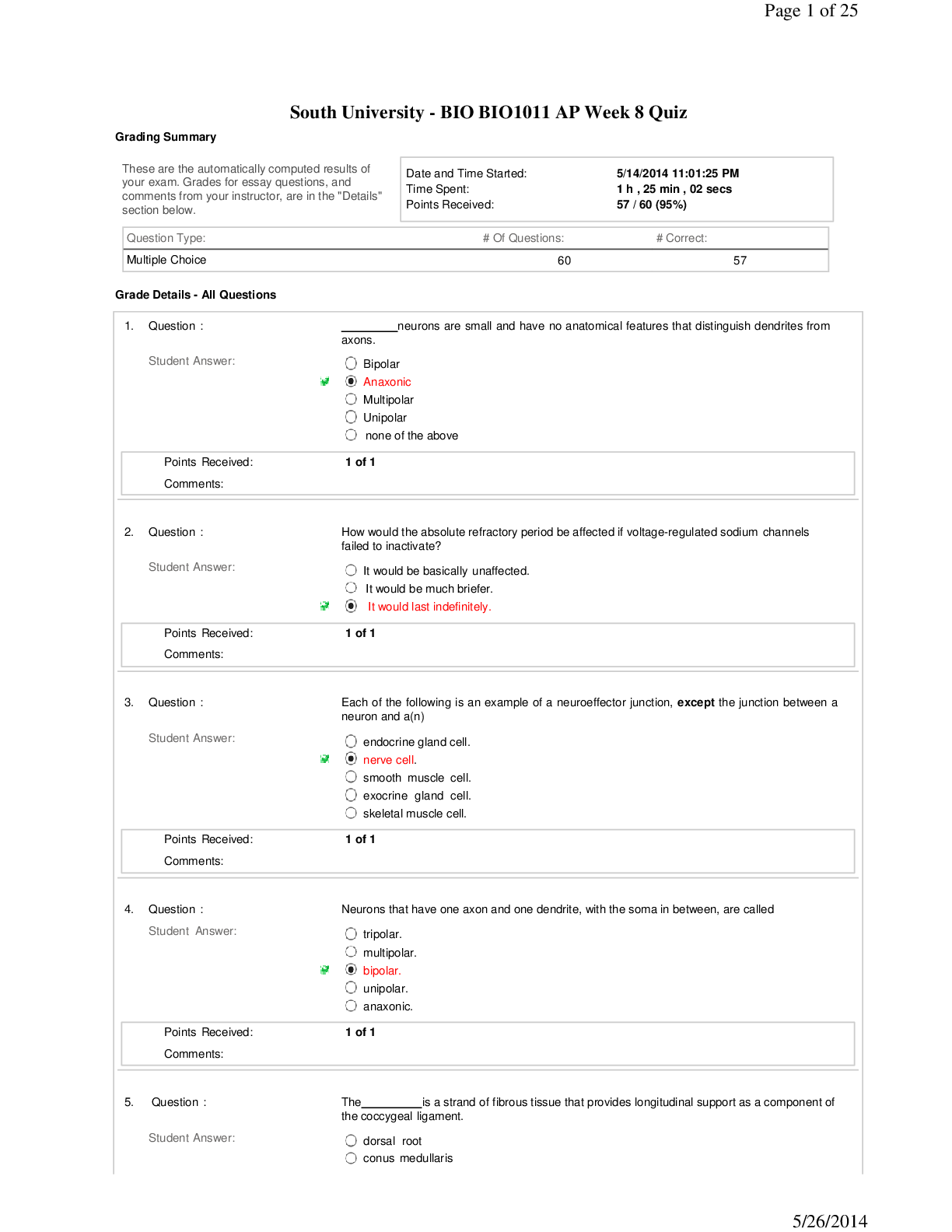
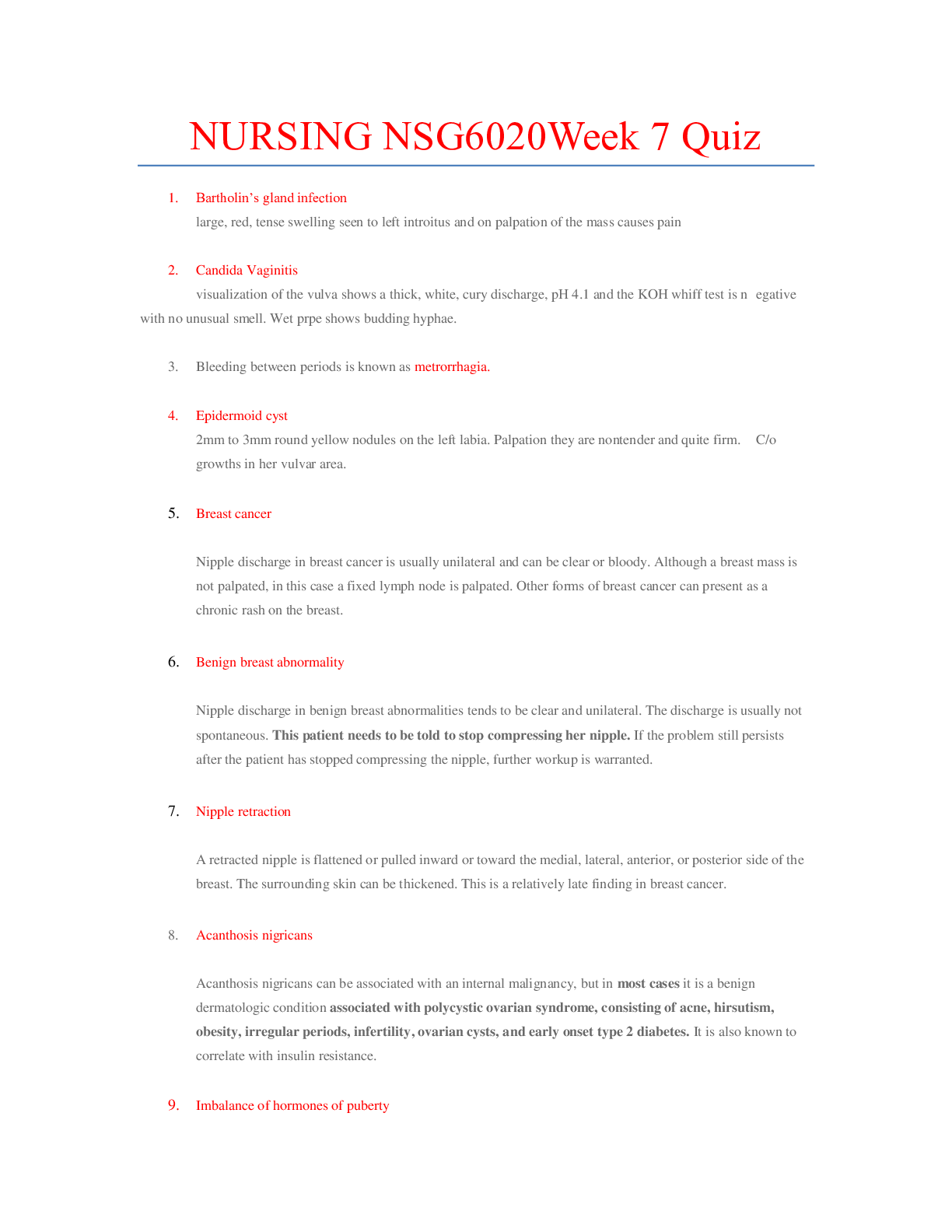
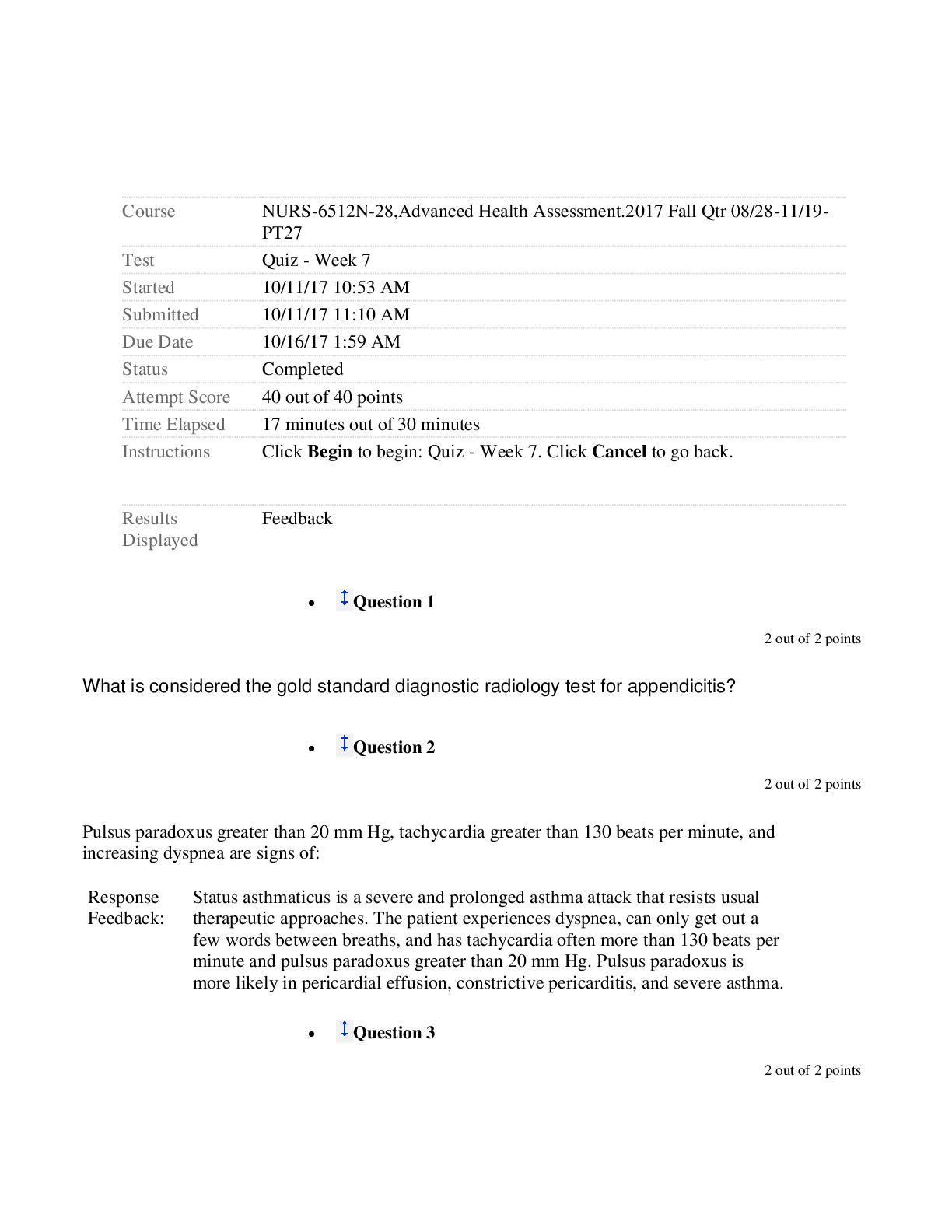



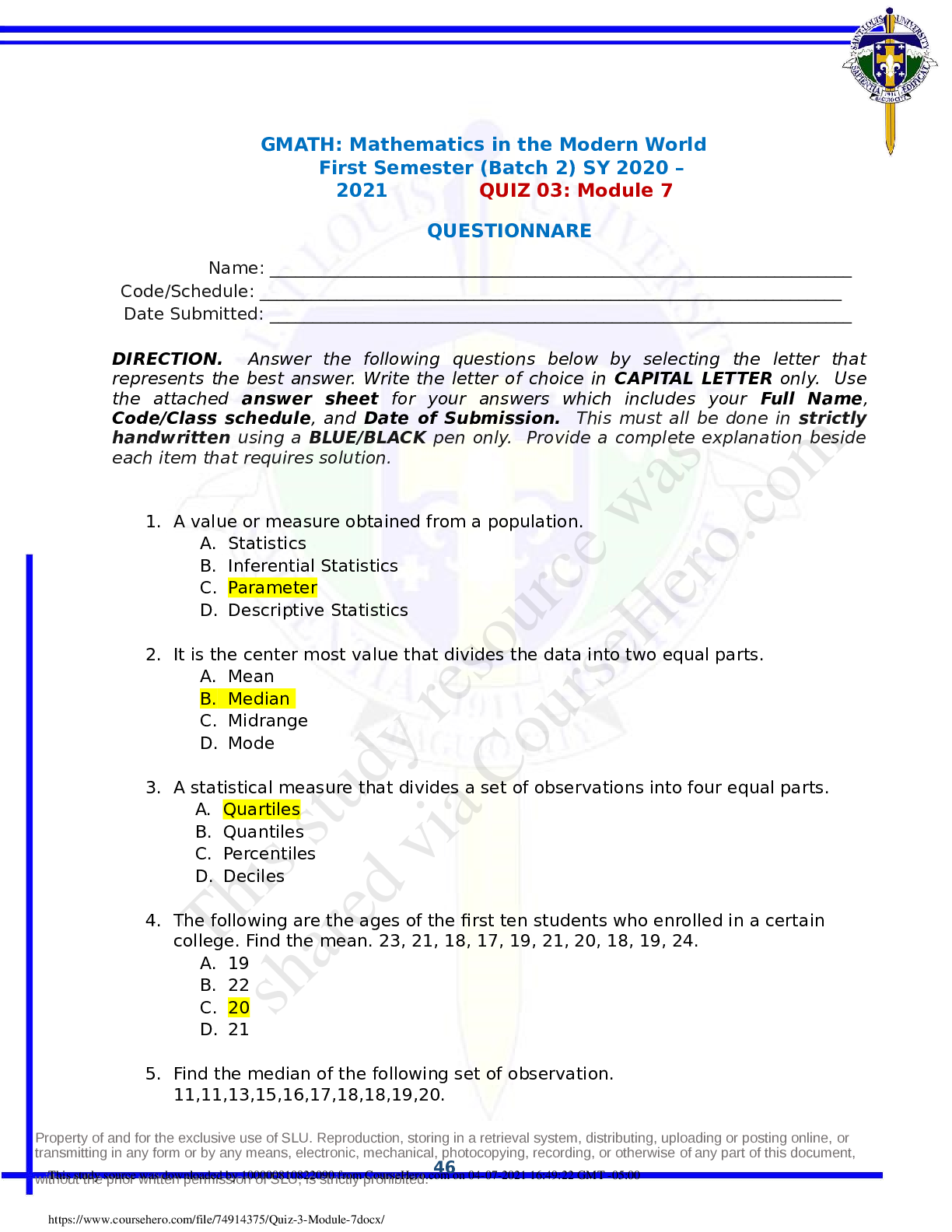



.png)


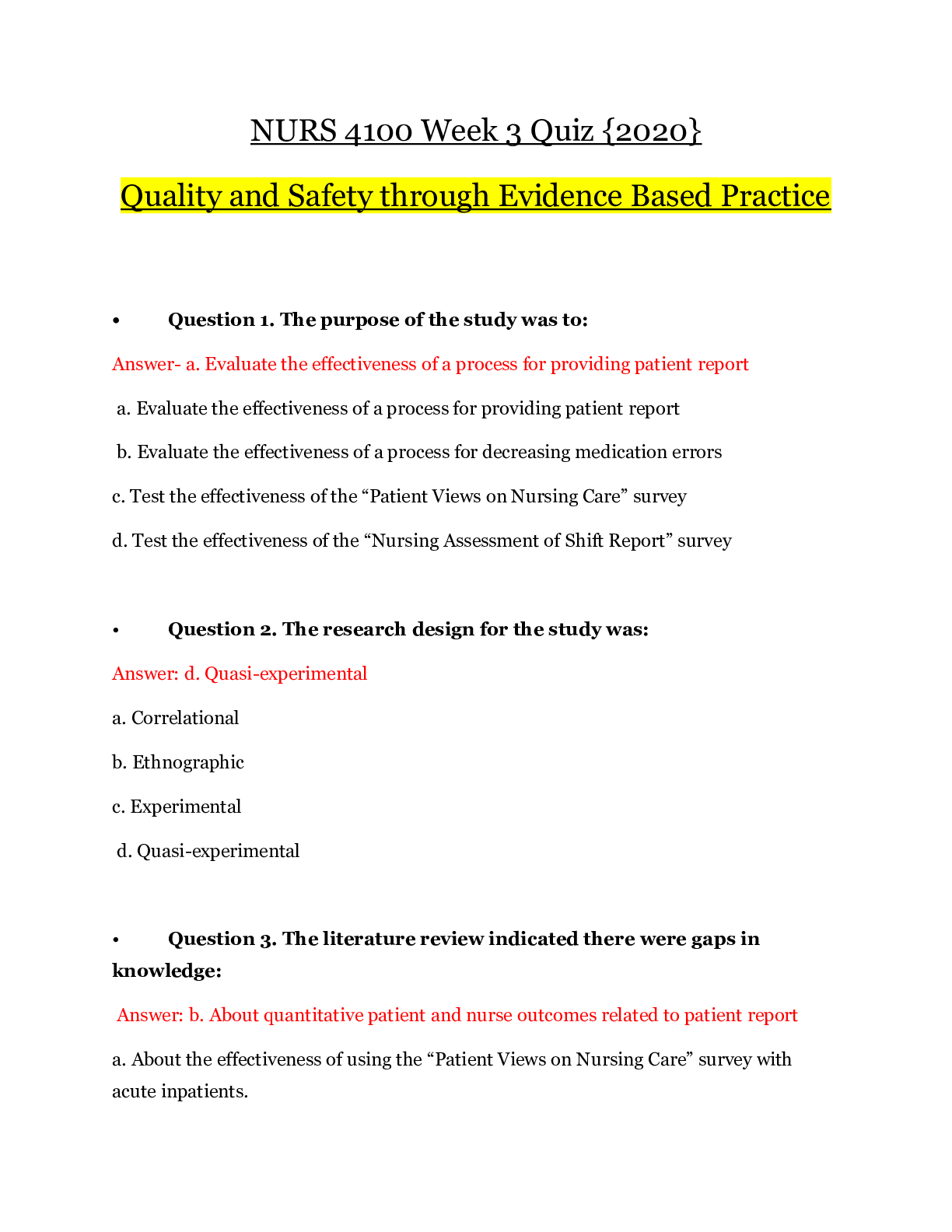
.png)
.png)
